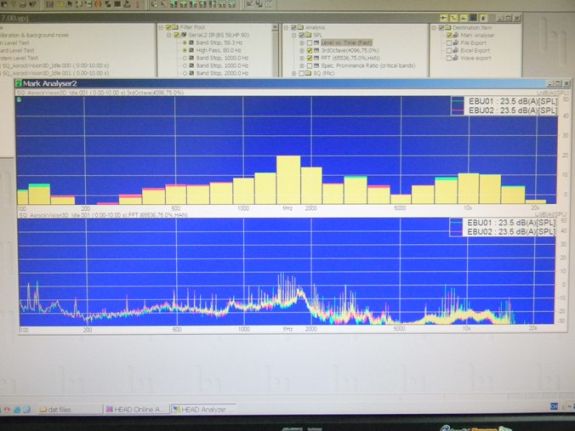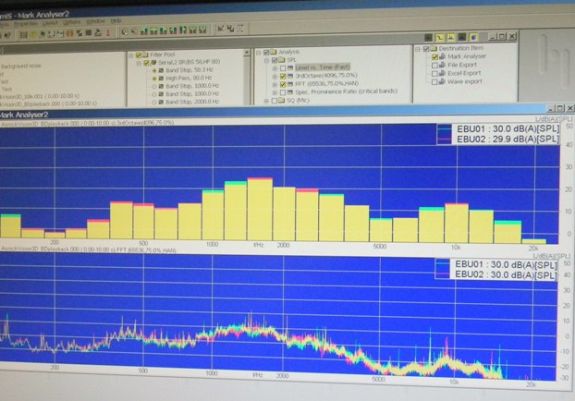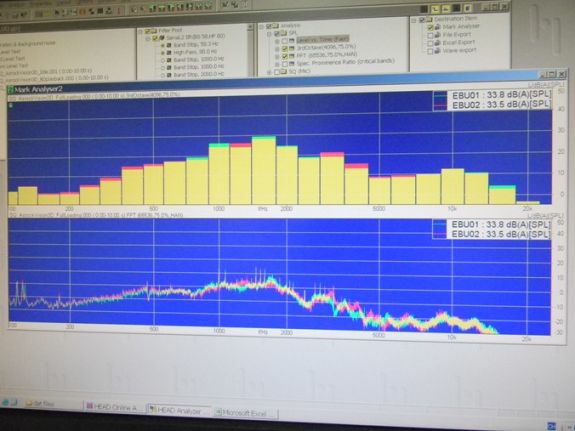ASRock's High-End Vision 3D HTPC Reviewed
by Ganesh T S on October 3, 2010 10:20 AM EST
HTPC enthusiasts are rightly concerned about the noise factor, heat and power consumption, ease of usage and many other criteria. We will tackle each of these concerns one by one in this section.
Noise
ASRock doesn't make any claims about the quietness of the system in their marketing material. We were pleasantly surprised upon looking at the noise reports. In the set of pictures below, a professional sound level detector was placed 2 ft away from the Vision 3D, and the sound level measurements were taken in various HTPC scenarios. The unit has a noise level of less than 35 dB at full load (for both CPU and GPU). In this respect, it is actually similar in performance to the Core 100. In fact, it is slightly better because of the elimination of one of the fans.
23.6 dB at Multimedia File Playback
33.8 dB at Full Load (Prime95 + Furmark)
Power Consumption
In order to get an idea of the power consumption numbers, the Prime95 and Furmark benchmarks were let run overnight to keep both the CPU and GPU completely loaded for an extended duration. Under these extreme conditions, we found the average power consumption to be around 82 W. At idle, the average power consumption was around 20 W.
These type of power consumption numbers have been enabled by ASRock's choice of going in for an Arrandale instead of a Clarkdale platform. This has resulted in a smaller form factor case design for the mini-ITX motherboard. Since there is not much heat to be dissipated, the cooling system is also appropriately small and silent.
Ease of Use
HTPC enthusiasts are concerned about how easy it is for their system to come out of standby. Existence of HDMI handshake issues upon return from standby is also a deal breaker for many. Fortunately, the Vision 3D has no issues in these two aspects. As long as the AC power adapter is connected to the system, the bundled MCE remote can be used to boot the system (even if the PC had been shut down previously). In order to shorten the boot times, ASRock supplies an Instant Boot utility. Using this, whenver the Vision 3D is shut down, it boots up once again and shuts down before the power can be safely removed. Upon power up, the boot up is instantaneous. If the user wants to put the PC in sleep mode, ASRock also supplies a Goodnight LED feature in the BIOS, which turns off the bright blue blinking LED in front. The MCE remote can also be used to bring the PC out of sleep mode.
Within Windows, the MCE remote can be made to work with a variety of applications such as XBMC, MediaPortal, MPC-HC and of course, Windows 7 Media Center. Blu Ray players such as PowerDVD and ArcSoft TMT can also be controlled with the help of the MCE remote. For the ideal I/O scenario, one probably needs to purchase a wireless keyboard / mouse combo.
It was seen in an earlier section that the Vision 3D happened to get a perfect score in the Anandtech Media Streamer Test Suite. The unit could playback all files using one program or the other, and people expect nothing else from a HTPC. Unfortunately, there is no single unified interface (from XBMC or MediaPortal or any other similar program) which could successfully play back all the files from within. There is definitely an ease of use issue existing here. However, this is not ASRock's fault, and will probably continue to exist on all HTPC platforms. Hopefully, projects such as XBMC's DSPlayer mature rapidly to alleviate this problem.














51 Comments
View All Comments
strolfey - Monday, October 4, 2010 - link
Thanks a bunch! Based on this, there's no major hangups so I'll be looking to get one as soon as it's available from newegg.cjs150 - Tuesday, October 5, 2010 - link
Bit like the Apple TV article, we are moving closer to the ideal living room HTPC but not there yet.A decent SSD rather than a HD would be better, less noise, reliability not an issue, less heat.
Noise is the issue for me. This is improving (and would be less noisy than my current cable box) but still not perfect (total silence would be perfect but impractical).
I do wonder whether an optical drive is really necessary. Seems to me that there may be 2 HTPC markets. One for a streaming device that can play games and another where the device is also the sole Blue-ray/DVD player on an AV system.
I would be happy to ditch the optical drive for a TV tuner. Even more so if it could replace the cable box
blacksun1234 - Wednesday, October 6, 2010 - link
Dear Ganesh,Is its BD playback video quality better than consumer BD 3D player?
ganeshts - Wednesday, October 6, 2010 - link
I didn't do a side by side comparison, but I would believe that you have lot more tweaks available at your disposal on the HTPC to do some post processing if you desire (compared to the options in a consumer BD 3D player).The only advantage of a consumer BD player I can foresee is the ease of use factor. HTPCs are inherently not designed to cater to the lowest common denominator yet. (Yes, we have Win7MC + PDVD / ArcSoft integration, but you still need to do some configuration like AutoStart / Start Maximized / configuration of 3D display etc. etc. to make sure it acts like a consumer BD 3D player).
SirMeili - Wednesday, October 6, 2010 - link
With my current HTPC, I can have distinct On and off Codes. so my question is this:You said you can wake the HTPC via the remote, but can you
1) put it to sleep with the remote, and
2) Turn the computer on with the remote (from an off state)
3) program additional codes for the IR Receiver (for instance, I have a button on my universal for alt-f4)
Neither are ultimately important, but I like my setup as it is now (especially since I can train specific on and off codes for my IR Receiver for the HP)
ganeshts - Wednesday, October 6, 2010 - link
1 and 2 are definitely possible ( 2, when AC power cord is still connected, but you already knew that :) )As for 3, I will ask ASRock. I haven't personally tried out.
The Jedi - Tuesday, October 12, 2010 - link
If this were an Asus brand product I might find it more attractive, but I think ASRock has issues with its reputation. I mean they make some innovative and low cost mobo's, but from reading around they seem to have quality control issues. Last time I visited their website they had imperfect English so I think I'll just stay away.mutarasector - Monday, November 29, 2010 - link
Can't wait to see a Llano powered version of this thing. I believe one might see a mini based on it by the 'Fruity computer Co.' in the not too distant future.borekb - Tuesday, February 1, 2011 - link
On these screen-less HTPC devices, how do you display things like MP3 or volume information while you're playing musing and the TV is turned off? I'm thinking about attaching a digital picture frame but would that be possible to output the signal to both HDMI (-> A/V Receiver -> TV) and to the frame? (I don't own any digital picture frame at the moment so I'm not sure what would be required on that front.)mpogr - Thursday, June 2, 2011 - link
Got one of these. They sell them here in Australia without memory and HDD, purchased both from the same store, the total price was ~940AUD (should be ~970-980 USD now)..Assembly was quite easy and all was working fine at first. Installed Windows 7 Ultimate 64 bits, SageTV client and PowerDVD 11 (planned primary use: TV and, occasionally, 3D Blu Ray playback). Because of TV being used by the children, the computer was always on (but not always playing back media). The unit died after ~5 days. I wasn't at home when this happened, but it just powered itself off. After that, upon disconnecting and reconnecting power, it came on and then off straight away. Resetting CMOS and pulling the BIOS battery out helped a bit, so now it doesn't power itself off after reconnecting the mains. The blower spins and the power led is lit, but no video output and no HDD activity. Disconnecing HDD and ODD didn't help.
So it's just dead. It can be the unit itself or the memory, as I don't have any spare SODIMMs to test. About to send the unit back to the retailer for investigation.